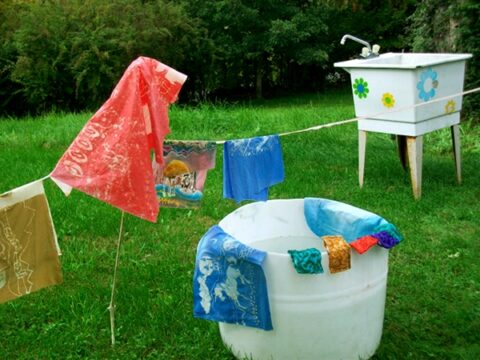

What is Batik?
Batik is an ancient process of painting with wax on fabric and then submerging the cloth in a dye bath. The wax acts as a resist to the dye and whatever sections have wax on them are not colored by the dye. A piece of fabric will then go through another painting of wax once the cloth is dry. Then another darker shade of dye is used for the next dye bath. Wherever the wax is, the color beneath it will be retained. If there is no wax, the subsequent dye baths will combine to generate a new color.
The process can be repeated for many waxing and dye baths for intricate designs or may only involve one or two steps for a more dramatic experience. Another effects involves discharge dyeing with bleach to remove sections of color. This process will allow colors to appear on a piece of cloth in both waxed and un-waxed areas when otherwise it wouldn’t be possible.
There are several different types of waxes that can be used for creating designs. Each has its own characteristics and they may be combined to achieve a mixed effect. The word batik actually comes from Indonesia and means “wax writing.” Wax is applied to the fabric using a tjanting tool to produce lines, and also with paint brushes.
Beeswax is one of the oldest waxes used and produces a smooth area with little to no crackling in the design. Paraffin is also used and will produce extreme crackling in the design by itself. The combination of the two will produce a pleasing visual effect for most work. Because of the independent nature of the wax and the interaction with the dye, the designs are always exciting and unique.
There are synthetic batik waxes on the market that mimic beeswax and may be combined with paraffin wax. There is also soy wax, which is a plant-based product that does not produce as crisp an image but has the advantage of being easier to remove from the cloth and is environmentally friendly.
Dye baths are a significant part of this process. Using color in tepid water with fixative agents, the designed piece must be carefully planned to maximize the visual effects. Some dyes may be painted on the fabric. However, on silk, special silk dyes are used which requires steaming or painting on a fixative to set the color before it is rinsed.
In the final steps, wax is removed by ironing the piece of cloth between sheets of plain newsprint or paper towels. Newspaper may be used to absorb extra wax as long as plain paper ONLY is next to the cloth so the print will not come off on the fabric. Wax has been boiled out of designs or dry cleaned. Soy wax may be washed out in very hot water and professional detergent.
Batik designs can be hung on dowels, framed, and in some cases displayed under glass. Batik makes exciting clothing and accessories because of its unique qualities and designs
